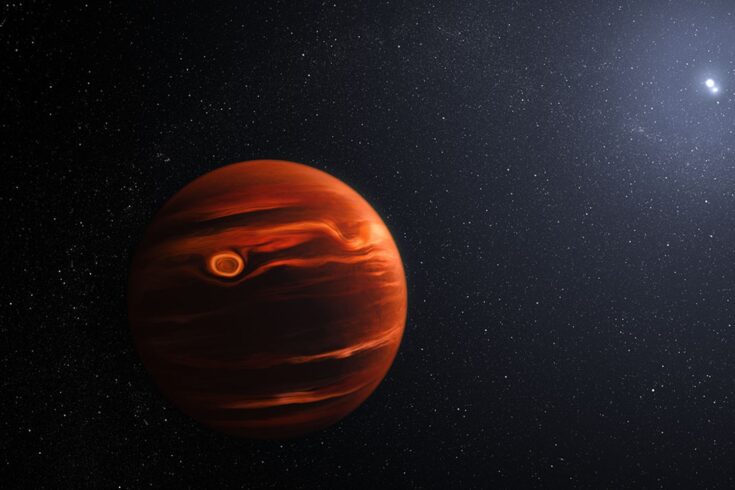The international team of researchers behind the study utilised the unique capabilities of the James Webb Space Telescope (JWST) Midi InfraRed Instrument (MIRI) and Near Infrared Spectrograph (NIRSPEC) instrument.
This enabled them to obtain previously inaccessible light spectra data from the planet VHS 1256 b, approximately 40 light-years from Earth.
Clouds on distant planets
Among other things, the data shows the first direct evidence of light being absorbed by silicate dust grains in the planet’s upper atmosphere.
Scientists have previously hypothesised that VHS 1256 b might have silicate cloud features because of its red colouring, which is characteristic of such planetary-mass objects, but the presence of silicate has only now been confirmed.
Professor Beth Biller, The University of Edinburgh and Royal Observatory Edinburgh (ROE) astronomer and co-author of the study said:
This is an exciting finding because it illustrates how different clouds on another planet can be from the water vapour clouds we are familiar with on the Earth.
These silicate clouds are like a perpetual, very fine-grained but very hot sandstorm in the atmosphere.
Directly observing them answers some longstanding questions in astronomical research and is a significant step on our journey to understand planetary-mass objects such as this.
Unprecedented accuracy
The low gravity of VHS 1256 b compared to other planetary-mass objects means that particles can appear and remain higher in its atmosphere where JWST can detect them.
The team also made extraordinarily clear detections of the largest number of molecules ever identified at once on a planet outside our solar system.
Professor Gillian Wright, Director at the STFC UK Astronomy Technology Centre (ATC) and European Principal Investigator for MIRI, said:
JWST is the only telescope that can measure all these molecular and dust features together.
The dynamic picture of the atmosphere of VHS 1256 b provided by this study is a prime example of the discoveries enabled by using the advanced capabilities of MIRI and NIRSpec together.
Changing our understanding
The data suggests that the atmosphere on VHS 1256 b is constantly rising, mixing, and moving, bringing hotter material up and pushing colder material down.
The resulting brightness changes make it the most variable planetary-mass object known to date.
Taken together, the insights from the study considerably improve our understanding of VHS 1256 b and similar planetary-mass objects.
Further information
The researchers observed VHS 1256 b as part of the JWST Early Release Science program, which is designed to help transform the astronomical community’s ability to characterise planets and the disks where they form.
The paper, entitled ‘The JWST Early Release Science Program for Direct Observations of Exoplanetary Systems II: A 1 to 20 Micron Spectrum of the Planetary-Mass Companion VHS 1256-1257 b,’ is published in the journal, Astrophysical Journal Letters.
The Webb mission
Webb is the world’s premier space science observatory. Webb will solve mysteries in our solar system, look beyond to distant worlds around other stars, and probe the mysterious structures and origins of our universe and our place in it.
Webb is an international program led by NASA with its partners, the European Space Agency (ESA) and the Canadian Space Agency.
The UK is playing a major role by leading the European Consortium. The UK, partnered with US institutes, designed, built and tested one of the four main science instruments, the MIRI, backed by UK government funding.
MIRI was developed through a 50:50 partnership between NASA and ESA. The Jet Propulsion Laboratory (JPL) led the US efforts for MIRI and a multinational consortium of European astronomical institutes contributed for ESA.
George Rieke with the University of Arizona is the MIRI US science team lead.
Gillian Wright with STFC’s UK ATC is the MIRI European principal investigator.
Alistair Glasse with UK ATC is the MIRI instrument scientist, and Michael Ressler is the US project scientist at JPL.
Laszlo Tamas with UK ATC manages the European Consortium.
The MIRI cryocooler development was led and managed by JPL, in collaboration with NASA’s Goddard Space Flight Center in Greenbelt, Maryland, and Northrop Grumman in Redondo Beach, California.
For more information, read the Webb Telescope news release.
Top image: Illustration of the swirling clouds identified by the James Webb Space Telescope in the atmosphere of exoplanet VHS 1256 b. Credit: NASA, ESA, CSA, Joseph Olmsted (STScI)

